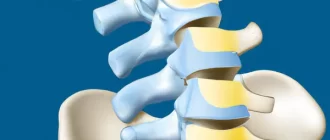Sciatica is a prevalent ailment that leads to discomfort along the body’s largest nerve, known as the sciatic nerve. The sciatic nerve originates from the lower back, passes through the buttocks, and travels down the back of both legs.
Severe pain that severely affects daily functioning can make it challenging to complete everyday tasks. This inclusive manual provides detailed information about sciatica, encompassing its origins, indicators, hazards, susceptibility factors, examination methods, therapies, preventive measures, and adjustments to one’s lifestyle.
Causes
The typical cause of sciatica is a herniated disc, in which the soft center of a spinal disc protrudes and puts pressure on the nerve root. Additionally, other factors like spinal stenosis, spondylolisthesis, muscle spasms, and lower back injury or trauma can also lead to this condition.
Symptoms
The primary sign of sciatica is feeling pain along the sciatic nerve. The level of pain can vary, from a mild throbbing to a sudden, sharp sensation. Other typical symptoms include a tingling or loss of sensation and weakness in the affected leg or foot. The pain may worsen when sitting, standing, or walking for long periods.
Dangers of Sciatica
Despite causing severe pain, sciatica does not pose a risk to life. Nevertheless, if not addressed promptly, it can result in long-lasting pain and lasting harm to the nerves. Furthermore, continued compression of the sciatic nerve can lead to weakened muscles and impaired coordination in the leg experiencing the condition.
Risk Factors
The likelihood of developing sciatica can be heightened by a number of elements, which include being between the ages of 40 to 60, leading a inactive lifestyle, being overweight, having diabetes, engaging in occupations that involve lifting heavy objects or sitting for long periods of time, and having a family background of back issues.
Diagnosis
A sciatica diagnosis is made by a healthcare provider through a thorough examination of the patient’s medical background, a physical examination, and the use of diagnostic tests like X-rays, MRI scans, or electromyography (EMG) to assess nerve activity and identify the site of nerve compression.
Treatment for Sciatica
The treatment choices for sciatica differ based on how severe the condition is. Mild treatments involve taking it easy, undergoing physical therapy, using nonsteroidal anti-inflammatory drugs (NSAIDs), and applying hot or cold compresses to reduce swelling. If the condition is more severe, doctors may suggest epidural steroid injections or surgery to alleviate the pressure on the affected nerve.
Prevention of Sciatica
Although there is no guaranteed method to completely avoid sciatica, there are various measures you can adopt to decrease the likelihood of experiencing it. These measures encompass maintaining proper posture, engaging in regular exercise to fortify the back and core muscles, adopting proper lifting techniques, avoiding extended periods of sitting or standing, and adhering to ergonomic principles in the workplace.
Lifestyle Changes
Implementing lifestyle changes can aid in the management and prevention of sciatica. These modifications involve keeping a healthy weight to decrease pressure on the lower back, abstaining from smoking, which can hinder blood flow and heighten inflammation, and integrating low-impact activities such as swimming into your daily schedule.
Conclusion
Sciatica is a condition that brings pain due to compression or irritation of the sciatic nerve. Although it can cause serious limitations, most instances can be handled with non-invasive treatments. By comprehending the reasons, symptoms, potential harm, factors that increase risk, diagnosis, treatment alternatives, ways to prevent it, and adopting a more positive way of life, people can relieve pain, aid in recovery, and decrease the likelihood of experiencing sciatica in the future.
About the Author
Reyus Mammadli is the author of this health blog since 2008. With a background in medical and biotechnical devices, he has over 15 years of experience working with medical literature and expert guidelines from WHO, CDC, Mayo Clinic, and others. His goal is to present clear, accurate health information for everyday readers — not as a substitute for medical advice.







